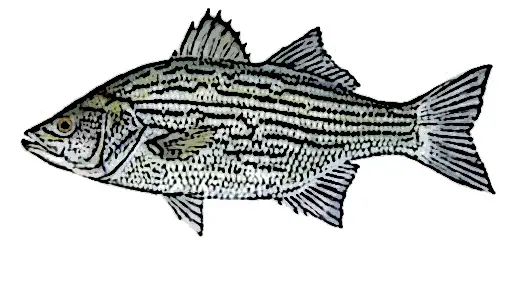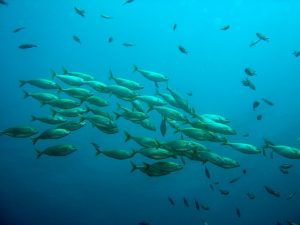White bass (also known as silver bass or sand bass) is a popular freshwater game fish found in many areas throughout the U.S. They are commonly fished in many lakes and rivers throughout the midwest and the southern United States. They are also the state fish of Oklahoma.
If you’re fishing for white bass, we created this guide for you. Here we will cover how to identify white bass, where to fish them, their seasonal patterns, the best equipment to catch them, and offer a few additional tips to help you catch more white bass.
What Do White Bass Look Like?

If you’re trying to identify white bass they are commonly a silver to white color or pale green. They usually have a dark back with white sides and a white belly. White bass also have dark stripes running horizontally across their bodies. They have large rough scales and two dorsal fins.
On average most white bass are between 10 and 12 inches in size, though some have been known to reach sizes up to 17 inches. The IGFA world record white bass measured approximately 18.5 in length weighing in at about 4.3 pounds.
Where to Catch White Bass
You can find white bass all over the United States. Particularly in the midwest to southern parts of the country. The great lakes regions, lake Erie, Arkansas river, Winnebago lakes system, and many Mississippi tributaries are common spots to catch these fish.
White bass tend to live in large rivers and reservoirs. They are also found in many shallow rivers, streams, and creeks. If you’re fishing a river system, look upstream.
White bass tend to migrate upstream and you can find huge populations of them.
In lakes look for the baitfish. White bass tend to swim around searching for baitfish, so where you find large schools of baitfish, you are sure to find hungry white bass nearby.
What Do White Bass Eat?
Juvenile white bass are known to eat a wide variety of larvae, bugs, and crayfish. Adult white bass eat minnows, shad, sunfish, yellow perch, saugers, drum, carp, bullhead, and other smaller fish species.
Seasonal Patterns
Fall
In the early autumn white bass tend to feed near the surface of the water in southern states. In northern parts of the U.S. and Canada, white bass move into deeper waters earlier in the fall as they head toward their winter destinations. Look for them in creeks, bays, and rivers feeding on schools of baitfish.
Winter
In the wintertime, white bass move into lakes and are usually found under large schools of baitfish. Look in deep basin areas where there are likely to be large schools of smaller fish for the white bass to feed on.
As the end of winter draws closer white bass move upstream to search for their spawning areas. In large reservoirs look in the upper section of the lake. They are found near deep holes near the tributary mouths where there is good current flow. In big rivers, they tend to spawn just below dams when their migration upstream is blocked. This is why in later winter tailwater fishing for white bass can be very productive.
Spring
Catching white bass in the spring can be difficult if you are not fishing in the right places. In the early springtime many smaller baitfish that white bass feed on move into the warmer parts of the lake which are shallower areas. The white bass follow their food to these areas and you can have a lot of success fishing in the shallows.
White bass tend to spawn in the spring from March to May. In the south, they spawn earlier. If you’re fishing the north white bass also spawn in late spring sometimes as late as June, so you can fish their spawning areas too depending on your location.
Summer
Fishing white bass in the summer is a favorite of many anglers. After white bass spawn, they return to open waters in lakes and can school in large numbers, making it a great time to fish. This is an ideal time to use your sonar to find huge schools in deeper waters. They also tend to come to the surface to feed on smaller baitfish, so you can look for the baitfish in the waters you are fishing to find hungry white bass nearby.
Equipment
Rods and Reels
For white bass we recommend either a spinning rod and reel or baitcasting rod and reel. For beginners, we highly recommend a spinning rod, because they are much easier to use and work well for most situations. Stick with a rod around 6’ to 7’ in length with a light to medium power. Make sure your reel can handle 4 to 8-pound test line, as this is what you will be using for white bass.
Baits and Lures
Spoons
A good spoon lure can be very effective for catching white bass. You can troll them when fishing large schools, or they can be cast or jigged. If you’re going to jig spoons look for large schools of baitfish that white bass eat such as shad. Cast your spoon and let it sink all the way to the bottom and bounce it, letting it fall back down. You can often get a white bass to chase your spoon this way.
Spinners
In early fall and summer when white bass come to the surface to feed on smaller baitfish, a spinnerbait can be highly effective. These work well when the fish are active and likely to give chase. Look for small schools of baitfish that come near the surface and cast your lure just past the strike zone. Gently reel your spinner through the area and you may get a hungry white bass to attack your bait.
Crankbaits
It’s always a good idea to carry a crankbait with you when targeting white bass. If you’re fishing in deeper waters try trolling them. During prespawn white bass tend to stay in depths around 14 feet. Target this depth when trolling your crankbait and you might find it works well.
Swimbaits
The best swimbaits are the ones that resemble what the white bass are already eating. In many areas, their food intake mostly consists of shad, so a swimbait that looks like this can work amazing when fished properly.
Shad
A little bit of live bait can make your presentation even more enticing to hungry fish. Since white bass are known to eat shad, using them as bait can be a great way to get the fish to bite.
Minnows
Live minnows also tend to work well. Hook them and let the minnows swim around a little bit to entice hungry white bass in the area.
Worms
You can also productively use worms when fishing for white bass. You can use them by themselves or tip your jigs with small wax worms and meal worms. These tend to work very well when ice fishing when the fish are a little bit slower.
Fishing Line
For white bass a 4 to 8-pound test monofilament line will work fine for most situations. Some anglers also like to use a lead of fluorocarbon when doing their fishing.
Hooks
A 3/0 to 4/0 hook should work well for most white bass fishing situations.
White Bass Fishing Tips

Find Schools of Baitfish
The hardest part of catching white bass is finding them in the first place. Your best bet is to find schools of smaller fish like shad that white bass are feeding on. If you’re fishing a large body of water like a lake you can be sure that hungry white bass are chasing around these smaller fish. You may have to use a GPS to successfully locate these schools.
Use Light Tackle
The average white bass is between 1 to 3 pounds, so remember to keep your tackle light. Smaller lures tend to work best for these fish. Let the white bass pull your lure and then set your hook. If you use too large of a lure you may not get the bass to bite, or be able to set your hook properly.
Keep Your Presentation on Their Level
White bass will only attack your lure if it is above them in the water, or at the same level, they are. They do not feed when the food is below them. So keep that in mind when casting your lure. Make sure to keep it either at the same level as them, or above the white bass.
Commonly Asked Questions
Where Do White Bass Spawn?
White bass are known to spawn in moving waters in tributary rivers. But they will also spawn in lake shores if the conditions are right.
What Temperature Do White Bass Spawn?
The best conditions for white bass spawning are between 54 to 60 degrees Fahrenheit. Usually, this occurs between mid-March to late May, sometimes even as late as June. They spawn earlier in the south, and later in the north.
Related Posts:
Best White Bass Lures
Rigs for White Bass
